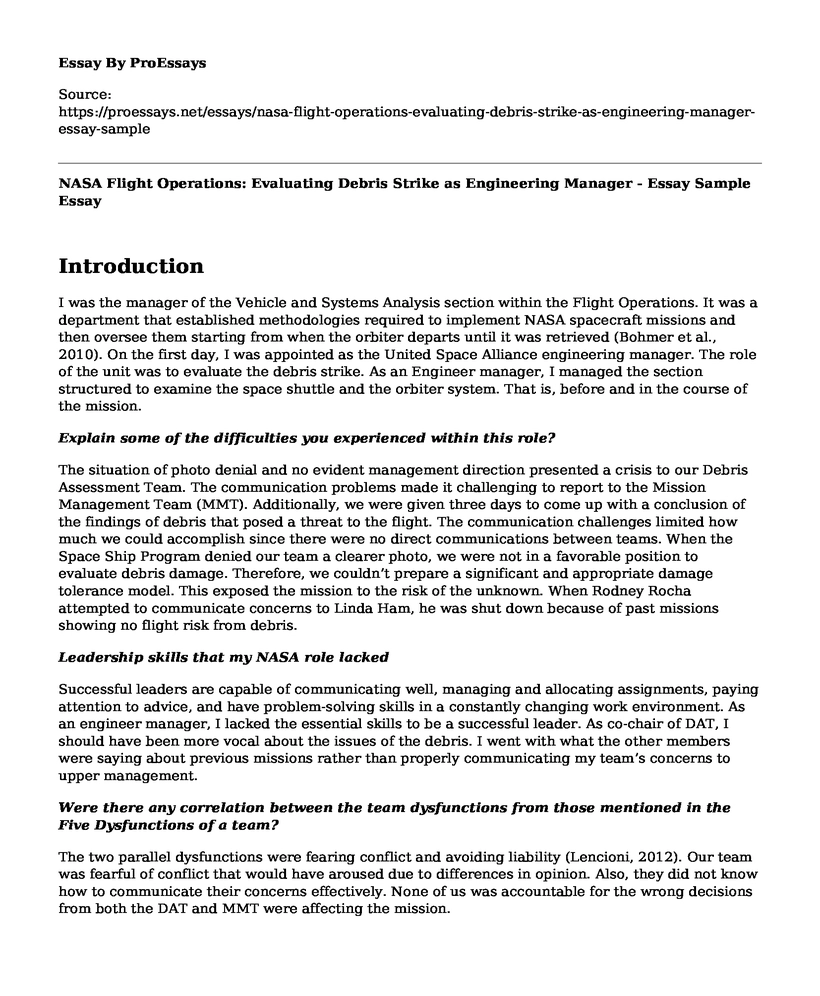Introduction
I was the manager of the Vehicle and Systems Analysis section within the Flight Operations. It was a department that established methodologies required to implement NASA spacecraft missions and then oversee them starting from when the orbiter departs until it was retrieved (Bohmer et al., 2010). On the first day, I was appointed as the United Space Alliance engineering manager. The role of the unit was to evaluate the debris strike. As an Engineer manager, I managed the section structured to examine the space shuttle and the orbiter system. That is, before and in the course of the mission.
Explain some of the difficulties you experienced within this role?
The situation of photo denial and no evident management direction presented a crisis to our Debris Assessment Team. The communication problems made it challenging to report to the Mission Management Team (MMT). Additionally, we were given three days to come up with a conclusion of the findings of debris that posed a threat to the flight. The communication challenges limited how much we could accomplish since there were no direct communications between teams. When the Space Ship Program denied our team a clearer photo, we were not in a favorable position to evaluate debris damage. Therefore, we couldn’t prepare a significant and appropriate damage tolerance model. This exposed the mission to the risk of the unknown. When Rodney Rocha attempted to communicate concerns to Linda Ham, he was shut down because of past missions showing no flight risk from debris.
Leadership skills that my NASA role lacked
Successful leaders are capable of communicating well, managing and allocating assignments, paying attention to advice, and have problem-solving skills in a constantly changing work environment. As an engineer manager, I lacked the essential skills to be a successful leader. As co-chair of DAT, I should have been more vocal about the issues of the debris. I went with what the other members were saying about previous missions rather than properly communicating my team’s concerns to upper management.
Were there any correlation between the team dysfunctions from those mentioned in the Five Dysfunctions of a team?
The two parallel dysfunctions were fearing conflict and avoiding liability (Lencioni, 2012). Our team was fearful of conflict that would have aroused due to differences in opinion. Also, they did not know how to communicate their concerns effectively. None of us was accountable for the wrong decisions from both the DAT and MMT were affecting the mission.
How could you have used the information to improve the groups’ effectiveness?
NASA would have allowed all teams to have briefings and ensure that every team had ample time to air out all the concerns. We should have held each other accountable for the decisions we made instead of dismissing them because of a lack of experience.
What lessons did you learn from the occurrence that will benefit your workplace and teammates?
I learnt that the proper exchange of information and ideas is crucial in the execution of any task. Allowing everyone involved in the team to display concerns are also very important and not always using pass assessments to achieve future goals. Just because something might have worked a few times within the organization does not imply that it will work in the future. As a leader, one should understand that a part of proper communication is listening and implementing plans based on the feedback received.
References
Accident Case Study of Organizational Silence. (2011). https://www.nasa.gov/pdf/553084main_Case_Study_Silence_Breakdown_Columbia_Rocha.pdf.
Bohmer, R. M., Roberto, M. A., & Edmondson, A. C. (2010). Columbia’s Final Mission - Case - Harvard Business School. https://www.hbs.edu/faculty/Pages/item.aspx?num=32162.
Lencioni, P. (2012). The five dysfunctions of a team: a workshop for team leaders. Pfeiffer.
Lencioni, P. (2012). The five dysfunctions of a team: Team assessment. Jossey-Bass.
Cite this page
NASA Flight Operations: Evaluating Debris Strike as Engineering Manager - Essay Sample. (2023, Aug 28). Retrieved from https://proessays.net/essays/nasa-flight-operations-evaluating-debris-strike-as-engineering-manager-essay-sample
If you are the original author of this essay and no longer wish to have it published on the ProEssays website, please click below to request its removal:
- Effect of Temperature on Enzyme Activity
- Customers Privacy Intrusion
- Artificial Intelligence and Theory of Mind Essay Example
- Catalyst Paper Example
- Research Paper on Walmart and IKEA
- Literature Review on Smart Devices and the Internet of Things
- Amazon Supermarkets: Strengthening Customer Trustworthiness & Revenue Growth - Essay Sample







